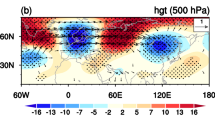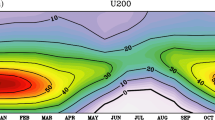Abstract
Wave trains propagating across Eurasia at both high and low latitudes in winter are key to the climate variation over East Asia via modulating the cold surge and moisture supply, with different configurations inducing diverse impacts. In this study, the combined impacts of the Eurasian (EU) pattern and South Asian jet wave train (SAJW) at a 10–30-day timescale are compared when they work in phase (indices of same signs) and out of phase (indices of opposite signs). Different configuration is defined by considering whether they induce a concurrent or reversing center of action over East Asia–Japan. The in-phase configuration induces a strong outbreak of the East Asian winter monsoon by intensifying the East Asian trough. In contrast, the out-of-phase configuration restricts the cold air over North China and enhances the moisture supply from the low latitudes by intensifying the India-Burma (now Myanmar) trough and an anomalous anticyclone over East Asia-the western North Pacific, inducing abnormal precipitation over Southwest and North China. In in-phase configuration, the EU pattern and SAJW are excited by abnormal disturbances over the western North Atlantic. The disturbance energy splits over Europe and joins over East Asia, intensifying the East Asian trough concurrently. In out-of-phase configuration, the two teleconnections do not share a common upstream source; they develop individually over the eastern North Atlantic in high and subtropical latitudes. They join north of the Bay of Bengal, resulting in a deepened India-Burma trough and an onward western North Pacific anticyclone anomaly. Both the EU pattern and SAJW influence the East Asian trough and the India-Burma trough in different configurations mainly via the advection of abnormal vorticity along wave trains by the subtropical westerly jet stream, with the anticyclonic Rossby wave source and Beta effect playing a negative role.












Similar content being viewed by others
Data Availability
All Japanese 55-year Re-Analysis data used during this study are openly available from the Japan Meteorological Agency at https://doi.org/10.2151/jmsj.2015-001 as cited in Kobayashi et al. (2015) and Harada et al. (2016). The daily CPC Global Unified Precipitation data used in this study are openly available from the NOAA PSL, Boulder, Colorado, USA, from their website at https://psl.noaa.gov as cited in Xie et al. (2007) and Chen et al. (2008).
References
Barnston AG, Livezey RE (1987) Classification, seasonality and persistence of low-frequency atmospheric circulation patterns. Mon Wea Rev 115:1083–1126. https://doi.org/10.1175/1520-0493(1987)115%3c1083:CSAPOL%3e2.0.CO;2
Branstator G (2002) Circumglobal teleconnections, the jet stream waveguide, and the North Atlantic Oscillation. J Climate 15:1893–1910. https://doi.org/10.1175/1520-0442(2002)015%3c1893:CTTJSW%3e2.0.CO;2
Bueh CL, Shi N, Xie ZW (2011) Large-scale circulation anomalies associated with persistent low temperature over southern China in January 2008. Atmos Sci Lett 12(3):273–280. https://doi.org/10.1002/asl.333
Chen M, Shi W, Xie P, Silva VBS, Kousky VE, Wayne Higgins R, Janowiak JE (2008) Assessing objective techniques for gauge-based analyses of global daily precipitation. J Geophys Res 113:D04110. https://doi.org/10.1029/2007JD009132
Chen YH, Duan AM, Li DL (2021) Connection between winter Arctic sea ice and west Tibetan Plateau snow depth through the NAO. Int J Climatol 41:846–861. https://doi.org/10.1002/joc.6676
Ding YH (1990) Build-up, air mass transformation and propagation of Siberian high and its relations to cold surge in East Asia. Meteorol Atmos Phys 44(1–4):281–292. https://doi.org/10.1007/BF01026822
Ding F, Li C (2017) Subtropical westerly jet waveguide and winter persistent heavy rainfall in South China. J Geophys Res Atmos 122:7385–7400. https://doi.org/10.1002/2017JD026530
Duchon CE (1979) Lanczos filtering in one and two dimensions. J Appl Meteor 18:1016–1022. https://doi.org/10.1175/1520-0450(1979)018,1016:LFIOAT.2.0.CO;2
Harada Y et al (2016) The JRA-55 reanalysis: representation of atmospheric circulation and climate variability. J Meteor Soc Japan Ser II 94:269–302. https://doi.org/10.2151/jmsj.2016-015
Hu KM, Huang G, Wu RG, Wang L (2018) Structure and dynamics of a wave train along the wintertime Asian jet and its impact on East Asian climate. Climate Dyn 51:4123–4137. https://doi.org/10.1007/s00382-017-3674-1
Huang SJ, Li XZ, Wen ZP (2020) Characteristics and possible sources of the intraseasonal South Asian jet wave train in boreal winter. J Climate 33:10523–10537. https://doi.org/10.1175/JCLI-D-20-0125.1
Jiao Y, Wu RG, Song L (2019) Individual and combined impacts of two Eurasian wave trains on intraseasonal East Asian winter monsoon variability. J Geophys Res Atmos 124:4530–4548. https://doi.org/10.1029/2018JD029953
Kobayashi S et al (2015) The JRA-55 reanalysis: General specifications and basic characteristics. J Meteor Soc Japan 93(5):48. https://doi.org/10.2151/jmsj.2015-001
Kosaka Y, Nakamura H (2006) Structure and dynamics of the summertime Pacific-Japan teleconnection pattern. Quart J Roy Meteor Soc 132:2009–2030. https://doi.org/10.1256/qj.05.204
Kuramochi M, Ueda H, Kobayashi C, Kamae Y, Takaya K (2021) Anomalous warm winter 2019/2020 over East Asia associated with trans-basin Indo-Pacific connections. Sci Online Lett Atmosphere 17B:9–13. https://doi.org/10.2151/sola.17B-001
Leung MYT, Zhou W (2015) Variation of circulation and East Asian climate associated with anomalous strength and displacement of the East Asian trough. Clim Dyn 45:2713–2732. https://doi.org/10.1007/s00382-015-2504-6
Li XZ (2021) Maintenance of the South Asian jet wave train: eddy kinetic energy balance. Clim Dyn. https://doi.org/10.1007/s00382-021-05735-7
Li C, Sun J (2015) Role of the subtropical westerly jet waveguide in a southern China heavy rainstorm in December 2013. Adv Atmos Sci 32:601–612. https://doi.org/10.1007/s00376-014-4099-y
Li XZ, Zhou W, Chen DL, Li CY, Song J (2014) Water vapor transport and moisture budget over eastern China: Remote forcing from the two types of El Niño. J Climate 23:8778–8792. https://doi.org/10.1175/JCLI-D-14-00049.1
Li XZ, Zhou W (2016) Modulation of the interannual variation of the India-Burma trough on the winter moisture supply over Southwest China. Clim Dyn. https://doi.org/10.1007/s00382-015-2575-4
Li XZ, Chen YQD, Zhou W (2017) Response of winter moisture circulation to the India-Burma trough and its modulation by the South Asian waveguide. J Climate 30:1197–1210. https://doi.org/10.1175/JCLI-D-16-0111.1
Li XZ, Wen ZP, Huang WR (2020) Modulation of South Asian Jet wave train on the extreme winter precipitation over Southeast China: comparison between 2015/16 and 2018/19. J Climate 33:4065–4081. https://doi.org/10.1175/JCLI-D-19-0678.1
Liu YY, Wang L, Zhou W, Chen W (2012) Variability of the Eurasian teleconnection pattern in the Northern Hemisphere winter and its influences on the climate in China. Chin J Atmos Sci 36(2):423–432 ((in Chinese))
Liu YY, Wang L, Zhou W, Chen W (2014) Three Eurasian teleconnection patterns: spatial structures, temporal variability, and associated winter climate anomalies. Clim Dyn 42:2817–2839. https://doi.org/10.1007/s00382-014-2163-z
Sakai K, Kawamura R (2009) Remote response of the East Asian winter monsoon to tropical forcing related to El Niño-Southern Oscillation. J Geophys Res 114:D06105. https://doi.org/10.1029/2008JD010824
Sardeshmukh PD, Hoskins BJ (1988) The generation of global rotational flow by steady idealized tropical divergence. J Atmos Sci 45:1228–1251. https://doi.org/10.1175/1520-0469(1988)045,1228:TGOGRF.2.0.CO;2
Son JH, Kim NH, Kim GU, Chu JE, Park JH, Kown J, Heo KY (2022) Early-onset trend in European summer caused by Greenland topographic effect. Environ Res Lett 17:104039. https://doi.org/10.1088/1748-9326/ac94e7
Song L, Wu RG (2017) Processes for occurrence of strong cold events over Eastern China. J Climate 123(16):8518–8537. https://doi.org/10.1175/JCLI-D-16-0857.1
Song L, Wu RG, An L (2019) Different sources of 10- to 30-day intraseasonal variations of autumn snow over western and eastern Tibetan Plateau. Geophys Res Lett 46:9118–9125. https://doi.org/10.1029/2019GL083852
Suo MQ, Ding YH, Wang ZY (2008) Relationship between Rossby wave propagation in southern branch of westerlies and the formation of the southern branch trough in wintertime. J Appl Meteor Sci 19:731–740
Takahashi C, Yoneyama K, Sato N, Seiki A, Shirooka R, Takayabu YN (2012) The Madden-Julian Oscillation and extratropical teleconnection over East Asia during the northern winter in IPCC AR4 climate models. J Meteor Soc Jpn 90A:361–371. https://doi.org/10.2151/jmsj.2012-A21
Takaya K, Nakamura H (2001) A formulation of a phase independent wave-activity flux for stationary and migratory quasi-geostrophic eddies on a zonally varying basic flow. J Atmos Sci 58:608–627. https://doi.org/10.1175/1520-0469(2001)058,0608:AFOAPI.2.0.CO;2
Takaya K, Nakamura H (2005) Mechanisms of intraseasonal amplification of the cold Siberian high. J Atmos Sci 62:4423–4440. https://doi.org/10.1175/JAS3629.1
Takaya K, Nakamura H (2013) Interannual variability of the East Asian winter monsoon and related modulations of the planetary waves. J Climate 26:9945–9461. https://doi.org/10.1175/JCLI-D-12-00842.1
Wallace JM, Gutzler DS (1981) Teleconnections in the geopotential height field during the Northern Hemisphere winter. Mon Wea Rev 109(2):784–812. https://doi.org/10.1175/1520-0493(1981)109%3c0784:TITGHF%3e2.0.CO;2
Wang MY, Tan BK (2020) Two types of the Scandinavian pattern: their formation mechanisms and climate impacts. J Climate 33:2645–2661. https://doi.org/10.1175/JCLI-D-19-0447.1
Wang N, Zhang YC (2015) Evolution of Eurasian teleconnection pattern and its relationship to climate anomalies in China. Clim Dyn 44:1017–1028. https://doi.org/10.1007/s00382-014-2171-z
Wang B, Wu R, Fu X (2000) Pacific-East Asian teleconnection: How does ENSO affect East Asian climate? J Climate 13:1517–1536. https://doi.org/10.1175/1520-0442(2000)013%3c1517:PEATHD%3e2.0.CO;2
Wang L, Chen W, Zhou W, Chan JCL, Barriopedro D, Huang R (2010) Effect of the climate shift around mid-1970s on the relationship between wintertime Ural blocking circulation and East Asian climate. Int J Climatol 30:153–158. https://doi.org/10.1002/joc.1876
Wang L, and Lu MM, (2017) The East Asian winter monsoon. The Global Monsoon System: Research and Forecast (3rd Edition). Edited by C. P. Chang, H. C. Kuo, N. C. Lau, R. H. Johnson, B. Wang, and M. Wheeler, 51–61, doi: https://doi.org/10.1142/9789813200913_0005.
Watanabe M (2004) Asian jet waveguide and a downstream extension of the North Atlantic Oscillation. J Climate 17:4674–4691. https://doi.org/10.1175/JCLI-3228.1
Wen M, Yang S, Kumar A, Zhang P (2009) An analysis of the large-scale climate anomalies associated with the snowstorms affecting China in January 2008. Mon Wea Rev 137:1111–1131. https://doi.org/10.1175/2008MWR2638.1
Xie P, Yatagai A, Chen M, Hayasaka T, Fukushima Y, Liu C, Yang S (2007) A gauge-based analysis of daily precipitation over East Asia. J Hydrometeorol 8:607–626. https://doi.org/10.1175/JHM583.1
Xu PQ, Wang L, Dong ZZ, Li YJ, Shen XC, Chen W (2022) The British-Okhotsk Corridor pattern and its linkage to the Silk Road pattern. J Climate 35:5787–5804. https://doi.org/10.1175/JCLI-D-21-0705.1
You QL, Wu T, Shen LC, Pepin N, Zhang L, Jiang ZH, Wu ZW, Kang SC, AghaKouchak A (2020) Review of snow cover variation over the Tibetan Plateau and its influence on the broad climate system. Earth-Sci Rev 201:103043. https://doi.org/10.1016/j.earscirev.2019.103043
Acknowledgements
This work is jointly supported by the National Natural Science Foundation of China (42175019), National Key Research and Development Programs of China (2019YFC1510400), Natural Science Foundation of Guangdong Province (2022A1515011879), Science and Technology Planning Project of Guangdong Province (2023B1212060019), and International Cooperation and Exchange Program of the National Natural Science Foundation of China (42120104001).
Funding
This work was supported by the National Natural Science Foundation of China (42175019), Natural Science Foundation of Guangdong Province (2022A1515011879), Guangdong Province Key Laboratory for Climate Change and Natural Disaster Studies (2023B1212060019), and International Cooperation and Exchange Program of the National Natural Science Foundation of China (42120104001).
Author information
Authors and Affiliations
Contributions
All authors contributed to the study conception and design. Material preparation, data collection and analysis were performed by Xiuzhen LI, Zhiping WEN and Wen ZHOU. The first draft of the manuscript was written by Xiuzhen LI and all authors commented on previous versions of the manuscript. All authors read and approved the final manuscript.
Corresponding author
Ethics declarations
Conflict of interests
The authors have no relevant financial or non-financial interests to disclose.
Additional information
Publisher's Note
Springer Nature remains neutral with regard to jurisdictional claims in published maps and institutional affiliations.
Appendix
Appendix
See Table 1.
See Fig.
Regression of 10–30-day 200-hPa geopotential height (gpm) based on the principal components of 8 REOF of 200-hPa geopotential height over (30°W–160°E, 45°–80°N). Only the results significant according to 90% confident level are shown. The representative 3 centers of action selected to calculate the EU index are marked as black dots. The explained variances of 8 REOF are shown in the upper right corner
13.
Rights and permissions
Springer Nature or its licensor (e.g. a society or other partner) holds exclusive rights to this article under a publishing agreement with the author(s) or other rightsholder(s); author self-archiving of the accepted manuscript version of this article is solely governed by the terms of such publishing agreement and applicable law.
About this article
Cite this article
Li, X., Wen, Z. & Zhou, W. Different configurations of the Eurasian pattern and South Asian jet wave train and their impacts on the winter climate over East Asia. Clim Dyn (2024). https://doi.org/10.1007/s00382-024-07176-4
Received:
Accepted:
Published:
DOI: https://doi.org/10.1007/s00382-024-07176-4





